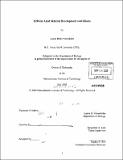| dc.contributor.advisor | Jacqueline A. Lees. | en_US |
| dc.contributor.author | Friesenhahn, Laurie Beth | en_US |
| dc.contributor.other | Massachusetts Institute of Technology. Dept. of Biology. | en_US |
| dc.date.accessioned | 2009-06-30T16:19:47Z | |
| dc.date.available | 2009-06-30T16:19:47Z | |
| dc.date.copyright | 2008 | en_US |
| dc.date.issued | 2008 | en_US |
| dc.identifier.uri | http://hdl.handle.net/1721.1/45802 | |
| dc.description | Thesis (Ph. D.)--Massachusetts Institute of Technology, Dept. of Biology, 2008. | en_US |
| dc.description | Includes bibliographical references. | en_US |
| dc.description.abstract | E2F transcription factors were originally identified as regulators of cell cycle and cellular proliferation. In vivo mouse models have uncovered novel roles for these proteins in different developmental processes. This dissertation examines the biological role of E2F6 in mammalian development. E2F6 functions as a repressor of transcription in concert with the polycomb group (PcG) proteins and chromatin modifiers. PcG proteins regulate processes required for proper embryonic development and differentiation. E2F6 interacts with core components of Polycomb Repressive Complex 1 (PRC1) and participates in PcG-mediated repression of Hox genes. Hox genes are required for correct patterning of the mammalian skeleton. Loss of E2f6 results in posterior axial skeletal transformations. Mice deficient for both E2f6 and Bmil, a component of PRC1, exhibit increased penetrance of axial skeletal transformations. Thus, E2F6 and Bmil cooperate in the regulation of Hox genes and axial skeletal development. Bmi 1 also represses transcription of the Ink4a-Arf locus, and it is consequently required to maintain the proliferative and self-renewal properties of hematopoietic and neural stem cells. However, E2F6 does not participate in the repression of the Ink4a-Arflocus. These findings underscore the significance of the E2F6-Bmil interaction in vivo and suggest that the Hox and Ink4a-Arfloci are regulated by somewhat different mechanisms. In addition to axial skeletal transformations, E2f6' mice exhibit a suppressed gliotic response after neural injury. Gliosis occurs in response to neurodegeneration, ischemia, and neuronal cell death. This process provides neuronal protection by restricting inflammation and regulating the concentration of molecules in the extracellular environment. | en_US |
| dc.description.abstract | (cont.) However, gliosis has potentially detrimental effects such as the inhibition of axonal regeneration or the release of cytotoxic agents that trigger degeneration of neighboring neurons. The molecular mechanisms required to initiate and sustain a gliotic response are poorly understood. Gliosis is the focus of therapy for neurodegenerative diseases and ischemia, and complete understanding of the mechanisms underlying this process will lead to more effective therapies for neurodegenerative disease and ischemia. | en_US |
| dc.description.statementofresponsibility | by Laurie Beth Friesenhahn. | en_US |
| dc.format.extent | 186 leaves | en_US |
| dc.language.iso | eng | en_US |
| dc.publisher | Massachusetts Institute of Technology | en_US |
| dc.rights | M.I.T. theses are protected by
copyright. They may be viewed from this source for any purpose, but
reproduction or distribution in any format is prohibited without written
permission. See provided URL for inquiries about permission. | en_US |
| dc.rights.uri | http://dspace.mit.edu/handle/1721.1/7582 | en_US |
| dc.subject | Biology. | en_US |
| dc.title | E2F6 in axial skeletal development and gliosis | en_US |
| dc.type | Thesis | en_US |
| dc.description.degree | Ph.D. | en_US |
| dc.contributor.department | Massachusetts Institute of Technology. Department of Biology | |
| dc.identifier.oclc | 319070089 | en_US |
